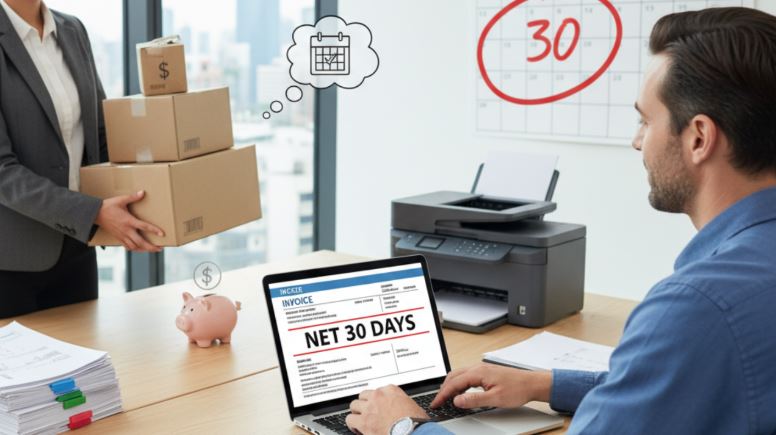Net 30 boosts cash flow flexibility, growth, and interest-free financing for clients and service providers.
If you are a small business owner, you have probably heard about Net 30 payment terms. You may consider offering them to attract clients, or a supplier wants to use them. But, here is the reality: most small business invoices are overdue by 30+ days, and the average small business gets currently owed in late payments.
This is not only the truth, but it is potentially your rent, payroll, or growth sitting in limbo. So, it is important to understand how Net 30 affects cash flow for both clients and service providers.
Let’s discuss the impact of Net 30 payment terms on both sellers and buyers.
Article Breakdown
Impact of Net 30 on Service Providers (Sellers)
1. Delayed Cash Inflow
Service providers who offer Net 30 terms have to wait for 30 days after delivery or invoicing to get payment from clients. This delay may create substantial liquidity challenges for the providers. They still need to cover their ongoing operational expenses, such as:
- Payroll
- Materials
- Rent
- Other fixed costs
So, the providers need to manage the challenges posed by delayed cash inflows. Here is how:
- Build a cash reserve
- Invoices are sent immediately upon delivery and follow-up.
- Diversify client base.
- Build strong relationships with clients.
2. Cash Flow Planning
Cash outflows such as payments to staff, suppliers, and overhead costs may occur before the cash inflows from client payments are received. This creates a mismatch between the timing of outgoing and incoming funds. For example, a service provider may need to pay employees and cover expenses such as rent, utilities, and inventory replenishment upfront, but they will have to wait up to 30 days.
During this gap, businesses must ensure that they have enough liquid capital or access to credit to cover their costs. So, service providers can prevent themselves from the negative consequences of poor cash flow management
- Forecast cash flow regularly.
- Have a cash reserve or emergency fund.
- Use short-term financing.
- Keep a close watch on the timing of incoming payments and adjust payment schedules accordingly.
3. Relationship and Growth
Service providers attract more clients due to the fact of offering flexible Net 30 terms. This flexibility helps:
- Close deals
- Drives customer loyalty
- Enhances competitive positioning
Impact of Net 30 on Clients (Buyers)
1. Positive Cash Flow Timing
Clients get immediate access to goods or services but defer payment for up to 30 days. This time flexibility allows the business to better manage its expenses and cash reserves within a 30-day period.
For example, they might purchase office supplies or inventory on Net 30 terms. With this arrangement, they can immediately use the supplies or sell the inventory to customers to generate revenue.
2. Interest-Free Financing
Net 30 terms act as short-term, interest-free credit. This means the businesses get a 30-day period to pay for the goods or services they have received.
Meanwhile, businesses can use this window to allocate their available cash to other critical areas, such as:
- Marketing
- Inventory
- Replenishment
- Unexpected costs like urgent repair or seasonal hiring spike
3. Potential Risks
These terms offer financial flexibility to businesses but they too come with certain risks such as:
Accumulation of Multiple Invoices
One of the primary risks is the collection of multiple invoices stacking up around the same time. The businesses rely on this payment structure to purchase a variety of goods and services, but they might end up with several payments due within the same month. This is especially common when purchasing office supplies or services from different suppliers on Net 30 terms. It is essential to:
- Carefully track all outstanding invoices and their due dates.
- Implement a robust invoice management system.
- Consider scheduling reminders.
Strained Supplier Relationships
Late or missed payments can strain relationships with key suppliers. Businesses that consistently fail to pay on time risk:
- Losing favorable payment terms
- Discounts
- Ability to place future orders
It is important to maintain open lines of communication with the suppliers. Inform your supplier if you foresee any issues related to meeting a payment deadline.
Poor Credit Ratings
Suppliers may report payment history to credit bureaus, which determine a business’s credit rating. If there are late or missed payments from your end, then you may develop a poor credit history.
A poor credit score makes it harder to:
- Access favorable financing options.
- Secure additional credit lines in the future.
4. Build Credit
When you pay under Net 30 terms promptly, it can help in building a solid credit history. A solid credit history:
- Enhance negotiating power with suppliers.
- Secure better pricing, discounts, and priority access to products and services.
- Help gain access to larger lines of credit during peak purchasing periods or unexpected expenses.
Bottom Line
Net 30 payment terms unlock opportunities and demand careful management from both sides. Service providers should not let cash flow challenges kill their business. They should plan ahead and diversify the client base. Buyers should treat these terms as the privilege they are. They should pay on time, communicate openly, and watch your credit score flourish.


